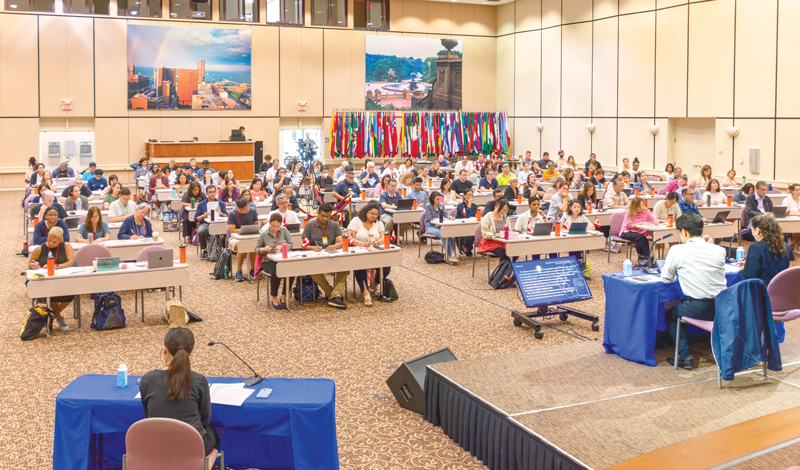WESTON, Fla.—“If the life of the Buddha is eternal, then why must the Buddha die?” SGI Study Department Leader Seiichiro Harada posed this question.
“By passing away, the Buddha arouses in the people the fundamental spirit of faith to seek the Buddha and the Law. The Buddha leads living beings to enlightenment by awakening in them a seeking spirit and desire to carry out faith, helping them reveal an eternal and vast state of life within.”
Mr. Harada presented this in his lecture on life and death, one of four topics studied at the Florida Nature and Culture Center (FNCC) from Aug. 23–26.
One hundred and eighty-five representative leaders from the SGI-USA and SGI-Canada gathered for the SGI North America Study Conference, led by Mr. Harada. It was the first study conference to be held at the FNCC since 2019.
In an exciting kickoff to the weekend, a young woman received the Gohonzon during the morning session on Aug. 24, the 77th anniversary of Ikeda Sensei joining the Soka Gakkai. She was among the hundreds who had joined the SGI-USA’s Buddhist community during its Summer of Shakubuku.
Over the four-day conference, Mr. Harada presented on key themes of faith: the unity of “many in body, one in mind” and the oneness of mentor and disciple (lecture 1), planting seeds (lecture 2) and joy in both life and death (lecture 3), with Q&A sessions interspersed throughout.
“Complex topics were explained in simple terms without losing Buddhism’s profundity,” said Eiji Toda, a young men’s division leader from Portland, Oregon. “I learned how I can study with the young men’s division leaders in my organization, always going back to Sensei’s guidance and the Gosho.”
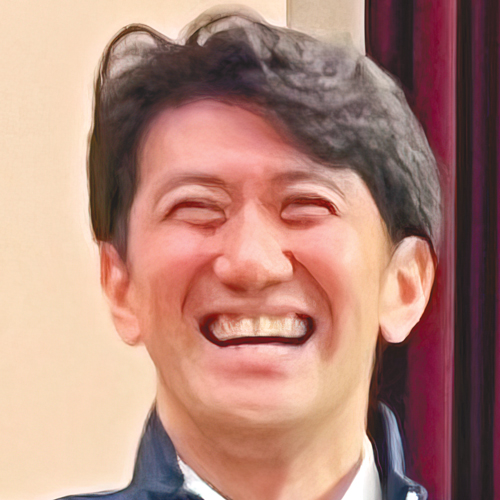
Seiichiro Harada
SGI Study Department Leader
‘The Heritage of the Ultimate Law of Life’ is passed on to those who practice in the spirit of ‘many in body, one in mind.’
In his first lecture, Mr. Harada presented on two key themes of faith: the unity of “many in body, one in mind” and the oneness of mentor and disciple based on chapters 8 and 9 of The Heritage of the Ultimate Law of Life: SGI President Ikeda’s Lecture Series.
Nichiren Daishonin wrote “The Heritage of the Ultimate Law of Life” to his disciple Sairen-bo while exiled on Sado Island. Sairen-bo, an educated former priest of the Tendai school, had asked Nichiren a question about the heritage of the ultimate law of life and death. He responded by describing the lineage of Buddhism passed down from the Buddha to all living beings.
In the letter, Nichiren explains three criteria for living beings to inherit the ultimate Law of life and death: 1) To have faith that the Buddha, the Law and living beings are entities of the Mystic Law and to chant Nam-myoho-renge-kyo with this conviction; 2) To sustain one’s faith throughout one’s life; and 3) To practice faith based on the unity of “many in body, one in mind.”
Mr. Harada focused on the third point, introducing this passage from the Gosho:
All disciples and lay supporters of Nichiren should chant Nam-myoho-renge-kyo with the spirit of many in body but one in mind, transcending all differences among themselves to become as inseparable as fish and the water in which they swim. This spiritual bond is the basis for the universal transmission of the ultimate Law of life and death. Herein lies the true goal of Nichiren’s propagation. When you are so united, even the great desire for widespread propagation can be fulfilled. But if any of Nichiren’s disciples disrupt the unity of many in body but one in mind, they would be like warriors who destroy their own castle from within. (“The Heritage of the Ultimate Law of Life,” The Writings of Nichiren Daishonin, vol. 1, p. 217)
Referring to this passage, Mr. Harada emphasized that the heritage is only passed on to those who practice with the spirit of “many in body, one in mind.” People who only pray for their own enlightenment cannot inherit the heritage of the Mystic Law.
Being “one in mind” means that even though personalities and characteristics differ, there is unity based on fighting toward a common goal and faith grounded in the shared commitment of mentor and disciple. For us, as practitioners of Nichiren Buddhism, it means cherishing the vow for kosen-rufu.
Explaining that devilish functions divide and obstruct unity, Mr. Harada said, “Faith and daimoku based on a shared commitment is the only way to defeat devilish functions.”
Sensei reiterates this point in his lecture on “The Heritage of the Ultimate Law of Life”:
The spirit of “many in body but one in mind,” in a sense, represents the ultimate manifestation of the “strategy of the Lotus Sutra,” which is chanting Nam-myoho-renge-kyo to the Gohonzon—specifically, chanting with a shared commitment for kosen-rufu.
No plans or strategies for kosen-rufu will succeed without such shared commitment in chanting. Strong practice based on such unity will also give rise to tremendous momentum. So even should there appear individuals who seek to disrupt the unity of our movement, their negative influence will be rebuffed by everyone’s focused spirit.
“One in mind,” or shared commitment, also refers to the great vow for kosen-rufu—the great vow of the Buddha who seeks to lead all people to enlightenment and also the great vow of the mentor. “One in mind” means making this great vow our own and working toward its actualization. The essence of this shared commitment can be found in chanting Nam-myoho-renge-kyo inspired by the wish for kosen-rufu, and this unity in chanting pulses vitally in the Soka Gakkai. (The Heritage of the Ultimate Law of Life, pp. 73–74)
When the hearts of individuals become one with their mentor’s heart to achieve kosen-rufu, the heritage of faith taught by Nichiren Daishonin can be transmitted to every person as well as throughout every corner of our organization, naturally giving rise to the unity of “many in body, one in mind.” Sensei explains:
Buddhism is a teaching conveyed through the mentor-disciple relationship. The oneness, or shared commitment, of mentor and disciple forms the essence of Buddhist practice. If we forget the mentor-disciple relationship, we cannot attain Buddhahood. Nor can we achieve eternal happiness or realize kosen-rufu. It is through the bond of mentor and disciple that the Law is transmitted. Buddhism is the Law of life; and the Law of life cannot be transmitted through words or concepts alone.
The heritage of the ultimate Law of life and death flows in the lives of those who strive for kosen-rufu based on the path of mentor and disciple. Please remember that without the mentor-disciple relationship, the flow of this heritage will be cut off. (The Heritage of the Ultimate Law of Life, p. 80)
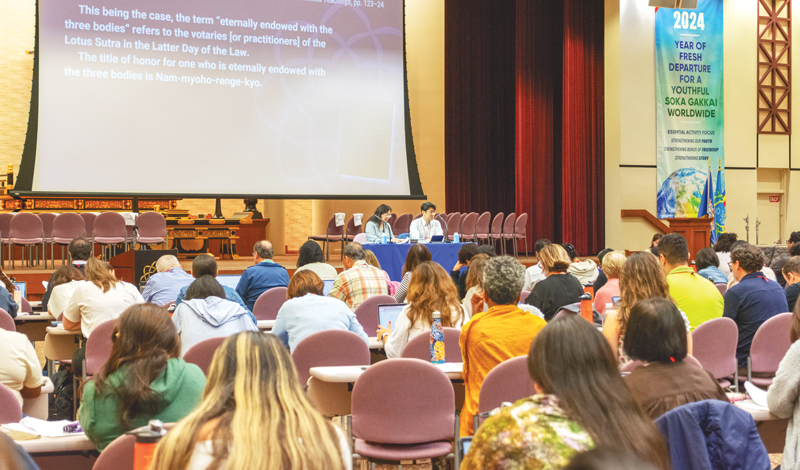
The ‘Life Span’ chapter embodies life’s most fundamental wisdom.
In his August 2022 headquarters leaders meeting message, Sensei wrote that The Record of the Orally Transmitted Teachings, which “elucidates the heart of the Lotus Sutra and the essence of Nichiren Buddhism, is a compilation of teachings that illuminates life with the light of the most fundamental wisdom.”
Soon after, Sensei’s lectures on the “Key Passages of The Record of the Orally Transmitted Teachings” began publication in the November 2022 issue of the Daibyakurenge, the Soka Gakkai’s monthly study magazine.
Mr. Harada underscored the significance of these lectures on The Record of the Orally Transmitted Teachings, stating that Sensei put his entire being into them right up to his very last days.
At the conference, Mr. Harada presented on parts 1 and 2 of Sensei’s lectures on the “Life Span of the Thus Come One” chapter, published in the July and August 2024 issues of Living Buddhism. Part 1 focuses on sowing seeds of Buddhahood and part 2 on joy in both life and death.
“You might feel a deep sense of familiarity with [the ‘Life Span’] chapter,” Mr. Harada said, pointing to the fact that we recite portions from the “Life Span” chapter every morning and evening during gongyo.
He shared three key points of this chapter of the Lotus Sutra outlined by Sensei:
- Shakyamuni did not attain enlightenment in this lifetime under the Bodhi tree; he attained enlightenment in the remote past.
- From the remote past to the eternal future, the Buddha preaches the Law in this saha world and continues to fight for the happiness of all people.
- The eternal Buddha undergoes birth and death as an ordinary human being. This is called “appearing to enter nirvana as an expedient means.”
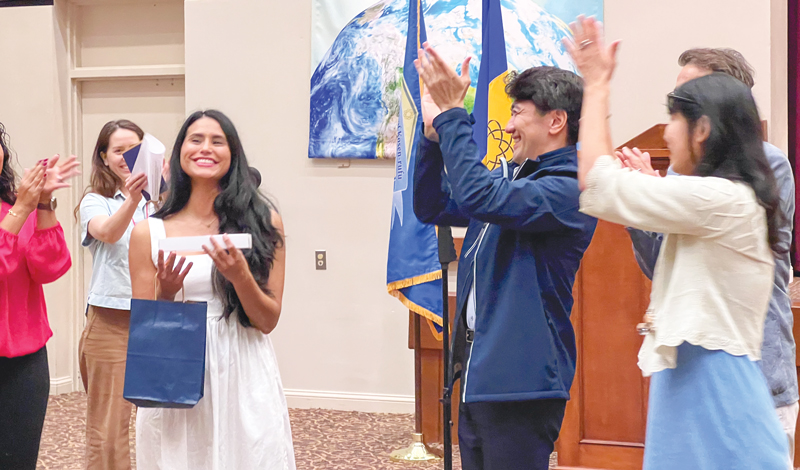
The time after the Buddha’s passing is the Buddhism of sowing.
Only the five characters of the daimoku [Nam-myoho-renge-kyo] constitute the Buddhism of sowing that is suitable for the present time. Thus, the Buddhism of the harvest is for the time when the Buddha was in the world, and the Buddhism of sowing is for the time after his passing. Hence it is the Buddhism of sowing that is needed in the Latter Day of the Law. (OTT, 126–27)
In his first lecture on the “Life Span” chapter, titled “Sowing the Seeds of Buddhahood—The Sacred Work of the Buddha to Bring Happiness to All People,” Sensei confirms how crucial the Buddhism of sowing is in the Latter Day of the Law.
Mr. Harada confirmed the three stages of spreading Buddhism—sowing, maturing and harvesting. Sowing refers to planting seeds. It entails planting the seeds, or sharing the essential Law for attaining Buddhahood, and helping people believe in this Law.
Maturing relates to making steady efforts to nurture the seeds we have planted.
Harvesting refers to reaping a crop. It means enabling people to liberate themselves from suffering and attain enlightenment.
Mr. Harada explained that the Buddhism of harvest was appropriate for Shakyamuni’s time because people back then had received the seed of Buddhahood in past lifetimes, with that seed maturing over lifetimes of practice, enabling them to liberate themselves and attain enlightenment.
In the Latter Day of the Law after the Buddha’s passing, however, people have lost their connection to Buddhism and very few are seeking it. Furthermore, the power and effectiveness of Shakyamuni’s Buddhism has waned. Therefore, what is needed now is the teaching of sowing, of planting the seed of Buddhahood and helping people make connections to Buddhism.
The core message of the Lotus Sutra is that Buddhahood is an inherent potential in each person’s life. However, a connection or spark is needed to call forth that Buddha nature. The mission of the Bodhisattvas of the Earth is to take action to help people form those connections.
Nichiren Daishonin revealed Nam-myoho-renge-kyo, the heart and essence of the Lotus Sutra, in this Latter Day. Mr. Harada affirmed that Nam-myoho-renge-kyo is the teaching to be spread in this age, and the people who will spread the Law after the Buddha’s passing are all of us—the Bodhisattvas of the Earth.
Sensei in his lecture offers three points regarding the significance of our Buddhist dialogues to plant seeds of Buddhahood:
First, sowing the seeds of is a way to create connections. It is the sacred task of bringing people in touch with the Mystic Law and opening the way to happiness for all. …
Second, sowing the seeds of Buddhahood means not discriminating; it is a noble undertaking to bridge divisions and bring people together. … It is the polar opposite of any tendency to discriminate against or denigrate others. … The Buddha’s all-embracing compassion, free of discrimination, vanquishes the ignorance of humanity that causes division.
Third, sowing seeds of Buddhahood means having faith; it is the admirable cause of promoting a way of life based on respect for others.
We don’t know when the seeds we have sown in people’s lives will sprout and blossom, but we respect the Buddha nature of each person and pray, wait for and believe that these seeds will flower. (July 2024 Living Buddhism, p. 59)
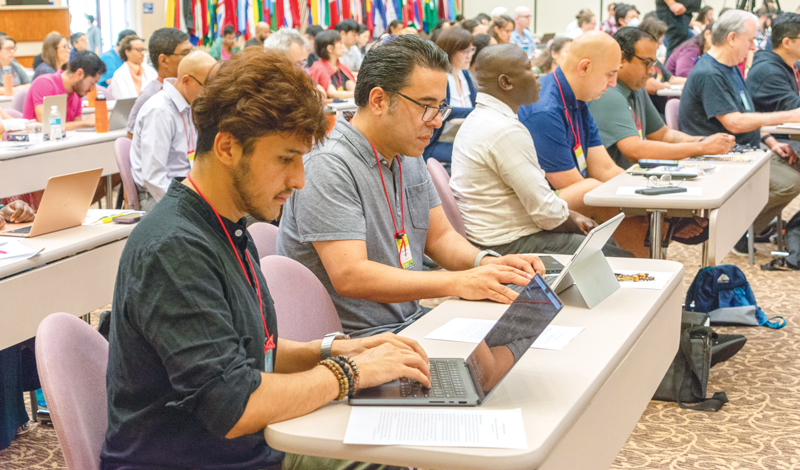
Joy can be experienced in both life and death.
Shakyamuni Buddha, Nichiren Daishonin and second Soka Gakkai President Josei Toda grappled with how to view life and death, a vital issue for most religions. Shakyamuni sought to liberate people from the four sufferings of birth, aging, sickness and death, concluding that without resolving these problems we cannot achieve true happiness.
The Daishonin expressed his view in “The Importance of the Moment of Death,” writing, “I should first of all learn about death, and then about other things” (WND-2, 759).
And Mr. Toda declared: “The final question Buddhism must settle is death” (August 2024 Living Buddhism, p. 52).
Sensei, in his September 1993 lecture at Harvard University, emphasized that correctly positioning death within the larger context of life is the greatest challenge of the 21st century. The core of his Harvard lecture lies in the well-known expression “joy in both life and death.” His main point was that through chanting Nam-myoho-renge-kyo, ordinary people who uphold the Mystic Law can experience joy in both life and death.
Mr. Harada said that the sufferings of birth and death are inescapable realities of life. He emphasized that a Buddha is a person who bravely fights to overcome the varied sufferings and problems amid harsh realities, citing these words from Sensei:
The Buddha as taught in the “Life Span” chapter is one who manifests great compassion and, over repeated phases of life and death, leads living beings to enlightenment in this saha world. In the same way, we Soka Gakkai members, while grappling with our own problems here in the reality of the threefold world, go out among those racked by the sufferings of birth, aging, sickness and death. With prayers of compassion and empathy, we act for our own and others’ happiness and for peace and harmony in society. As “envoys of the Thus Come One,” we carry out “the Thus Come One’s work” (see The Lotus Sutra and Its Opening and Closing Sutras, p. 200), undertaking the same actions as the Buddha to guide people to enlightenment. (August 2024 Living Buddhism, pp. 55–56)
Nichiren Buddhism views life and death as two aspects of the eternal nature of existence. President Toda likened life to the universe, saying that upon death our lives merge with the universe. In the same way that the universe has no beginning or end, our lives have no beginning or end. We are not “reborn” or “reincarnated,” but rather, our lives continue in different forms from this existence to the next.
Nichiren says:
The aspect or characteristics of the threefold world are birth, aging, sickness, and death. But if we look at birth and death in terms of their true nature, then there is no birth or death. And if there is no birth or death, then there is no ebb or flow. Not only do birth and death not exist. To look on birth and death with repulsion and try to escape from them is termed delusion, or a viewpoint of acquired enlightenment. Seeing and understanding the originally inherent nature of birth and death is termed awakening, or original enlightenment.
Now when Nichiren and his followers chant Nam-myoho-renge-kyo, they realize the originally inherent nature of birth and death, and the originally inherent nature of ebb and flow. (OTT, 127)
Sensei says that when we base ourselves on this perspective of life and death, there is no need to abhor or fear death. He writes that by chanting Nam-myoho-renge-kyo, we can gain deep conviction in the eternity of our lives and “bring forth the power to live this life in the most meaningful and fulfilling way” (August 2024 Living Buddhism, p. 57).
When we base ourselves on the great Law of Nam-myoho-renge-kyo, we can “acquire an eternally indestructible life state that is not swayed by the sufferings associated with the realities of life and death,” Mr. Harada explained.
He then relayed the story of a women’s division member who Sensei introduced in one of his essays. Thirty years ago, she discovered that she had cancer. Assailed by worry and anguish about the thought of dying, she hoped that her diagnosis was not real.
In reality, she was quickly moving toward death. Even so, while she intellectually understood that daimoku was the only way to overcome her suffering, she felt helpless.
It was in her hopelessness that she received a poem from Sensei that read: “Confidently live out your life and triumph over all, laughing off the devil of illness to become a queen of longevity” (The Wisdom for Creating Happiness and Peace, part 1, revised edition, p. 272). Shortly after, Sensei sent her two more messages telling her not to worry or be intimidated by illness and to remain positive, no matter what, keeping in mind that from the standpoint of the eternity of life, we are Buddhas in life and death.
Gaining conviction through her mentor’s words, she devoted herself to chanting daimoku each day.
While her fear of dying had not disappeared, she said she could now survey her illness and death from above, and through chanting, developed optimism, knowing that death would come as a matter of course. Thirty years have passed since her diagnosis, and she has recovered remarkably, continuing to do SGI activities in high spirits and encourage others with her experience.
While many members have triumphed over illness, Mr. Harada shared, there are also many who have overcome the devil of illness but have still passed away. Sensei also writes:
Because life and death are originally inherent, we have no reason to fear death and can savor joy in both life and death and be equally happy and at ease with both.
Of course, as mortal human beings, the idea of death can make us feel sad and forlorn. When a loved one dies, waves of grief assail us. But if we steadily continue chanting Nam-myoho-renge-kyo, we can transcend the bounds of life and death and converse with our loved ones. Fellow members will also chant for us and support us in our loss. In time, we will come to find the profound meaning of our loved one’s death and feel a sense of hope for renewal. (August 2024 Living Buddhism, p. 58)
The fact that we can find profound meaning in a loved one’s passing through our Buddhist practice reflects the profundity of Nichiren Buddhism’s perspective on life and death. Nichiren teaches that death is a short rest before beginning a new journey for kosen-rufu.
Throughout eternity, we will be “constantly reborn in company with” our teacher, carrying out bodhisattva practice.
The key to revealing our Buddhahood and experiencing abiding joy in life and in death is chanting Nam-myoho-renge-kyo, sharing Buddhism and applying Buddhist study to our daily lives.
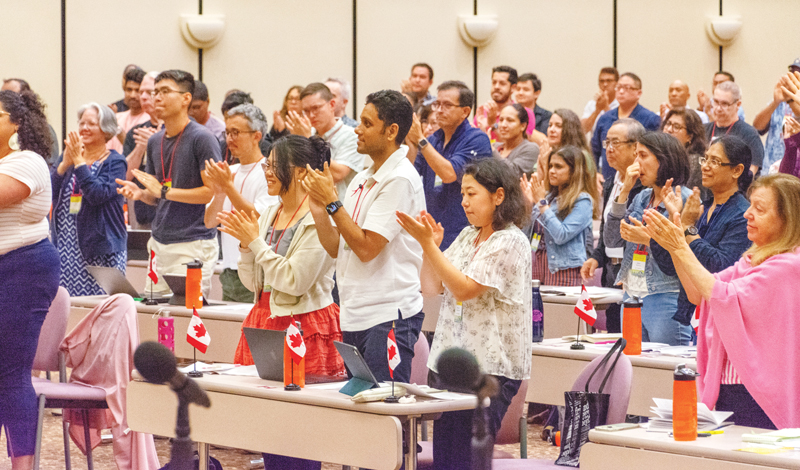
Let’s stand up together with our mentor to transform the destiny of humankind.
Mr. Harada reminded the participants that they had studied the Lotus Sutra passage “Those persons who had heard the Law dwelled here and there in various Buddha lands, constantly reborn in company with their teachers” (“The Heritage of the Ultimate Law of Life,” WND-1, 217).
“As mentor and disciples of the Mystic Law, we will live together eternally, carrying out our bodhisattva practice,” he said. “There is no journey of life that is more sublime than this.”
He then encouraged everyone to put into practice what they learned over the weekend and bring it back to their local organizations, adding, “Precisely because we live in a time of many crises that are threatening the dignity of life, as people who possess Buddhism’s eternal perspective on life and the nature of life and death, let’s stand up together with our eternal mentor Ikeda Sensei to do our human revolution and transform the karma of humankind!”
“I have a renewed sense of mission and purpose,” said Sedem Adiabu, a young women’s division leader from Alexandria, Virginia. “I am here because of Sensei. I want to impart that spirit to my fellow youth and show them why it’s important to have a mentor.”
September 6, 2024, World Tribune, pp. 6–9
You are reading {{ meterCount }} of {{ meterMax }} free premium articles

